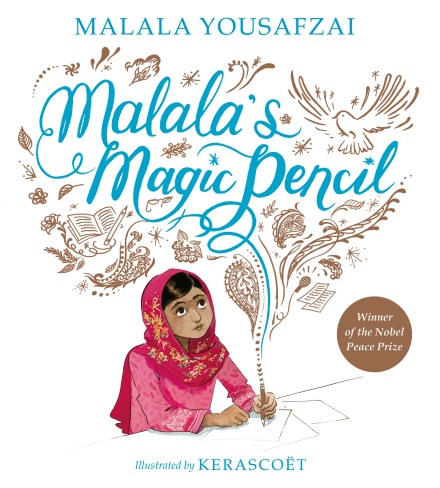Malala’s Magic Pencil
Written by Malala Yousafzai
Illustrated by Kerascoët
Little, Brown Books for Young Readers, 2017, 48 pp.
ISBN: 978-0316319577
2018 Jane Addams Children’s Book Award
Winner, Books for Younger Children
Malala’s Magic Pencil is Malala Yousafzai’s sensitive retelling of her remarkable story for younger readers. Many people are familiar with Malala Yousafzai’s incredible work bringing attention and access to quality education for girls in her homeland of Pakistan. She began writing for the BBC at age eleven about life under the Taliban, spreading the word about girls who had left school out of fear of the regime in her war-torn country. Her steadfast courage, even after a brutal Taliban attack on Malala and other girls as they rode the bus home from school, is revealed in Malala: My Story of Sticking Up for Girls’ Rights (2018) as well as her best-selling memoir I Am Malala: How One Girl Stood Up for Education and Changed the World (2016).
One might wonder about anyone’s ability to weave such a dark story into a book appropriate for younger readers. Through the magic of her words, Yousafzai does just that. In Malala’s Magic Pencil, she shares her parents’ love and inspiration, her passion for education, and her conviction that the world can be a better place when people work together.
As a young girl in Pakistan, Malala wishes for a magic pencil that can stop time, put a lock on her bedroom door so her brothers won’t pester her, draw beautiful dresses for her mother, and make the world a more peaceful place — ordinary wishes from a seemingly ordinary girl. But Malala is anything but ordinary. As she reveals in the picturebook, “My voice became so powerful that the dangerous men tried to silence me. But they failed.” Fierce in asserting the importance of education for girls verbally and in writing, Malala realizes she possesses all the magic she needs — in her words and in her work. Indeed, Malala’s resolve is not weakened by the Taliban. Her story is cherished by people the world over, and in recognition of her courage to champion universal access to education, she became the youngest person to win the Nobel Peace Prize, in 2014, at the age of 17. Malala’s story is one of empowerment, equality, and using one’s voice to speak out for justice.
Lively, even whimsical, illustrations convey Malala’s personal triumph and her continued commitment to peace and justice. Gold ink drawings are interspersed with watercolor to create a sense of magic. Small snapshot-like images of her girlhood dreams, larger close-ups of her with her father, and detailed drawings of her hometown gently bring her story to life for younger readers. Though the dangers she and other girls faced are conveyed in this picturebook, readers are left with a strong sense of inspiration and hope. One can imagine Malala surrounded by children and adults, addressing them directly, just as she does in the text. Her message is simple: “One child, one teacher, one book and one pen can change the world.”
Malala’s Magic Pencil conveys the extraordinary bravery of young activist girls as also seen in The Youngest Marcher: The Story of Audrey Faye Hendricks, A Young Civil Rights Activist (Cynthia Levinson and Vanessa Brantley-Newton, 2017) and Brave Girl: Clara and the Shirtwaist Makers’ Strike of 1909 (Michelle Markel and Melissa Sweet, 2013), Addams Award Winner in 2014. Older readers may wish to examine women activists in Claudette Colvin: Twice Toward Justice (Phillip Hoose, 2009), a 2010 Addams Award Honor book; and The Girl from the Tar Paper School: Barbara Rose Johns and the Advent of the Civil Rights Movement (Teri Kanefield, 2014), Addams Award Winner in 2015. Each of these books examines female activists who fought hate and injustices in peaceful and creative ways. Steamboat School (Deborah Hopkinson and Ron Husband, 2016), a 2017 Addams Award Winner; and Caldecott Medal Winner, Henry’s Freedom Box (Ellen Levine and Kadir Nelson, 2007) feature male activists and complement the story of Yousafzai’s unwavering campaign for education and peace.
Tracy Randolph, St. Andrew’s-Sewanee School, Sewannee, TN
WOW Review, Volume XII, Issue 2 by Worlds of Words is licensed under a Creative Commons Attribution-NonCommercial-ShareAlike 4.0 International License. Based on work at https://wowlit.org/on-line-publications/review/xii-2/

